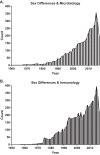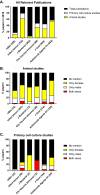Sex Reporting in Preclinical Microbiological and Immunological Research
- PMID: 29138308
- PMCID: PMC5686541
- DOI: 10.1128/mBio.01868-17
Sex Reporting in Preclinical Microbiological and Immunological Research
Abstract
Both sex (i.e., biological construct of male and female) and gender (i.e., social construct of masculine and feminine) impact the pathogenesis of diseases, including those caused by microbial infections. Following the 2015 NIH policy for consideration of sex as a biological variable in preclinical research, in 2018, authors of papers published in primary-research American Society for Microbiology (ASM) journals will be asked to report the sex of the research subjects and animals and of materials derived directly from them. To address the need for sex reporting in ASM journals, we systematically reviewed 2,928 primary-research articles published in six primary-research ASM journals (Antimicrobial Agents and Chemotherapy, Clinical and Vaccine Immunology, Infection and Immunity, Journal of Bacteriology, Journal of Virology, and mBio) in 2016. Approximately 37% of animal studies and 9% of primary cell culture papers published in 2016 would have been affected by the new sex-reporting policy. For animal studies (i.e., studies with any nonhuman vertebrate hosts), most published papers either did not report the sex of the animals or used only female animals, and a minority used only males or both sexes. For published studies using primary cells from diverse animal species (i.e., humans and nonhuman vertebrates), almost all studies failed to report the sex of donors from which the cells were isolated. We believe that reporting the sex of animals and even of the donors of derived cells could improve the rigor and reproducibility of research conducted in microbiology and immunology and published in ASM journals.
Keywords: immunology; microbiology; sex reporting.
Copyright © 2017 Potluri et al.
Figures


References
-
- Klein SL, Pekosz A, Passaretti C, Anker M, Olukoya P. 2010. Sex, gender and influenza. World Health Organization, Geneva, Switzerland.
-
- WHO Ebola Response Team, Agua-Agum J, Ariyarajah A, Blake IM, Cori A, Donnelly CA, Dorigatti I, Dye C, Eckmanns T, Ferguson NM, Fraser C, Garske T, Hinsley W, Jombart T, Mills HL, Nedjati-Gilani G, Newton E, Nouvellet P, Perkins D, Riley S, Schumacher D, Shah A, Thomas LJ, Van Kerkhove MD. 2016. Ebola virus disease among male and female persons in West Africa. N Engl J Med 374:96–98. doi:10.1056/NEJMc1510305. - DOI - PMC - PubMed
Publication types
MeSH terms
LinkOut - more resources
Full Text Sources
Other Literature Sources

